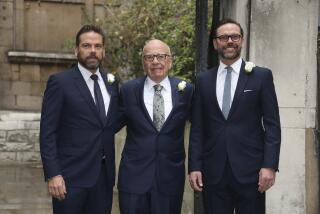Foreigners Await Vote on Australian Media Rules
- Share via
SYDNEY — Australia’s plans to overhaul its 20-year-old media laws may provide further opportunities for global media magnates looking to spread their influence.
Foreign investors have been restricted to stakes of 15% in television and as much as 25% in newspapers. And cross-media ownership rules have prevented investors from owning television stations and newspaper operations in a single market.
Even under the proposed changes, investors will still need approval from the Treasury’s Foreign Investment Review Board, which examines all substantial overseas investments.
Yet the new rules, if they overcome the obstacles that still lie in their path, will “open up possibilities,” said Peter Williams, finance director of the Daily Mail & General Trust of Britain.
He supervises the company’s Australian radio investment, run by Paul Thompson, a local radio guru, and has often toyed with the prospects that any change in media rules might bring. Williams said the company, which bought a small stake in Ten TV in the 1980s, might be interested in print and television assets. But he added: “Prices in Australia have tended to be pretty high.”
Ireland’s O’Reilly family has been an even more long-term player in Australia, through the local arm of their Independent News & Media group. The group owns 40% of APN News & Media, which includes 14 regional newspaper titles, radio and outdoor advertising. But Anthony O’Reilly has been frustrated over the last two decades in his ambitions to control some of Australia’s most prized media assets.
His son Gavin, chief operations officer of the media group, said he expected significant activity across all media if the changes went through. “It will make all media assets more tradable, and you know the Aussies like to do deals,” he said. It would free IN&M; to own newspapers and radio in the same metropolitan area, he added.
Fifteen years ago, the media group was involved in a bruising but unsuccessful battle for control of John Fairfax Holdings, publisher of the leading broadsheets, the Sydney Morning Herald and the Age, as well as the Australian Financial Review.
Fairfax is still the most likely takeover target. But for O’Reilly a bid for Fairfax might now be significantly more complicated.
Media analysts point out that a bid for Fairfax would trigger competition issues as Fairfax has in recent years acquired newspaper assets in New Zealand, where Independent News & Media is already the dominant player through APN, publisher of the New Zealand Herald and nine regional daily titles.
Instead, the first opportunities in the media shake-up could be in regional media, where APN has a strong hand through its regional newspaper network.
Rupert Murdoch’s News Corp., owner of the Australian, a newspaper, is considered a foreign company after it moved to the U.S. from Australia. It could buy a TV company if the rules are relaxed.
Australian media executives believe that Pearson, owner of the Financial Times, also will be interested in making local acquisitions, especially the Australian Financial Review. But it is expected to concentrate on building the FT brand in Australia.
For those eager to take advantage of the opening up of Australia’s media market, there are a number of political hurdles to be overcome.
Helen Coonan, federal communications minister, hopes to present new laws to parliament late this year after industry consultations finish April 18. But the legislation could still take months, even years, to come into effect. Even then, foreign players could be blocked on national-interest grounds, an argument that has been used in other sectors, such as oil.
Andrew Edgecliffe-Johnson contributed to this report.
More to Read
Sign up for Essential California
The most important California stories and recommendations in your inbox every morning.
You may occasionally receive promotional content from the Los Angeles Times.










